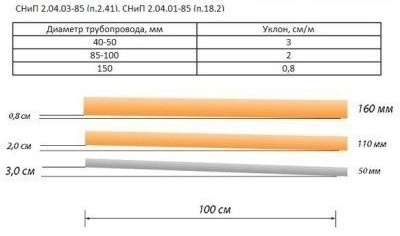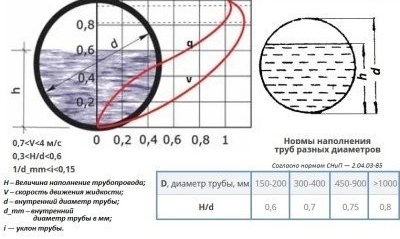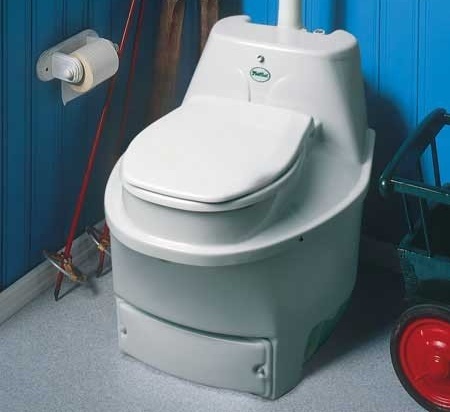Which slope of the sewer pipe is considered optimal in various situations

It is impossible to lay pipes on the principle of “how it will turn out,” since in most houses a gravity drainage system is mounted. But it is very capricious: insufficient slope of the sewer pipe leads to blockages, too large - to leaks and increased noise. Since runoff waters contain food debris, fats, and small debris, plaque forms on the walls, and they overgrow with time. The angle of inclination in the specialized literature is indicated in centimeters, and not in degrees, as is customary. We suggest you figure out how to properly apply the standards and make calculations.
How to calculate slope values correctly?
In all specialized literature: reference books, norms and rules - the slope of the external sewer pipe is given in the form of a decimal fraction. The numbers 0.07 or 0.003 indicate the ratio of the height of the drop to the length of the drainage system. Data can easily be converted to familiar units, for example, seven centimeters or three millimeters per meter. To calculate which slope of the sewer pipe (H) to do, you just need to multiply the pipe length (L) by the slope (x).
The initial data for the calculation:
- L = 5600 millimeters;
- x = 0.07;
- H = L * x = 5600 * 0.07 = 392 millimeters.
The optimal height difference between the beginning and the end of the drainage system was 39.2 centimeters.

The main parameters for determining the slope of sewer pipes are their diameter and length. However, when designing, many forget that the number of turns and joints of the drainage system is also important. Consider the number of discharge points and the nature of the effluents. Agree that for the toilet and the washbasin they will differ significantly
The slope of the sewer pipe depends on the diameter of the drain. With a diameter of 50 millimeters, one side should be lowered by 30 millimeters per meter. At 20 millimeters, an 11-centimeter pipe is lowered on each meter. For a drainage system with a diameter of 16 centimeters, the minimum slope is 0.008 meters (8 mm). If the calculation is made for large pipes (Ø 200 mm), you need to tilt the pipe by seven millimeters per meter.
We measure the slope of the internal pipeline
According to the SNIP, the slope of the pipes in the apartment depends on the diameter. In the kitchen and in the bathroom, different pipes are used, so there are minimum and normal values. Within these values and should work.
For washing in the kitchen, as well as sinks, urinals, washbasins and bathtubs, 40 or 50 mm pipes are usually used, for which the normal slope is 0.035 and the minimum is 0.025. When installing the toilet for runoff water, take a bypass line with a diameter of 100 millimeters. For him, the minimum slope is 0.012, and normal is 0.02.
To calculate the desired angle, it is better to use a laser or bubble level. Sex, no matter how smooth it may seem, cannot serve as a standard of horizontalness.It’s cheaper to buy the right tool than to remodel the sewer or do repairs to yourself and your neighbors.
Standards for outdoor sewage pipes
Building regulations contain the optimal slope dimensions of the external sewer pipes. Their diameter is significantly larger than that used for installation of internal drainage systems.
It is categorically impossible to significantly exceed the set values, otherwise the sewer system will not be able to work correctly: the pipes will silt and clog very quickly.
For a pipe of Ø150 millimeters, the normal slope is 0.008 meters or 0.8 centimeters per meter of length. For a two hundred-millimeter pipeline, this value is less, and is 0.007 m or 0.7 cm.
For conditions when it is impossible to create a normal slope, the minimum permissible parameter values are determined: 0.007 m (0.7 cm) and 0.005 m (0.5 cm) for pipes with a diameter of 150 and 200 millimeters, respectively.

Too large a slope will lead to siltation: water will not wash away solid particles of sewage, which adhere to the walls and narrow the lumen. As a result, water locks in siphons can break
The maximum allowable slope is 0.15 meters or 15 centimeters per 1 m.
Determine the fullness of the outlet pipes
When laying a drainage system, not only what slope of the sewer pipe will be made is important, but also the level of its fullness. For calculations, the following formula is used:
K = H / D, where
- K is the fullness of the sewer pipe;
- H is the height of the level of effluents in the drainage system;
- D is the diameter of the sewer pipe.
The rate of fullness is one if the pipe is completely flooded. For an empty drainage system, the value of K is zero.

Optimum filling of sewer pipes ranges from 50% to 60%. The breakdown is due to the possibility of using pipes with different roughness of the inner surface. The insufficient filling of the gutter negatively affects its service life: the flow of air to the walls in such an aggressive environment contributes to the destruction of materials
The optimal value of K, at which the system operates in normal mode, is in the range from 0.5 to 0.6.
The numbers can fluctuate within these limits depending on the materials from which they are made. All of them are distinguished by the ability to form a boundary layer. For asbestos-cement or ceramic pipes, for example, the rate of fullness should be 0.6. They are rougher than the same plastic, for which the recommended filling is 0.5.
Subject to these indicators, the waste water will pass at a speed of about 0.7 m / s. This is enough to keep the solid particles in suspension and prevent them from settling and sticking to the pipe walls.
As a result, the design parameters of the sewer pipeline should correspond to the formula:
K≤V√y, where
- K is the filling of the sewer pipe (optimal value is 0.5-0.6);
- V is the speed;
- √y is the square root of the pipeline occupancy.


